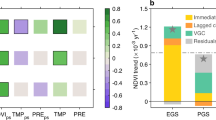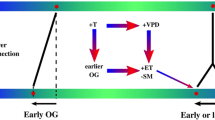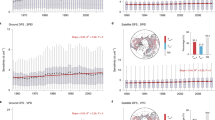Abstract
Spring vegetation growth can benefit summer growth by increasing foliage area and carbon sequestration potential, or impair it by consuming additional resources needed for sustaining subsequent growth. However, the prevalent driving mechanism and its temporal changes remain unknown. Using satellite observations and long-term atmospheric CO2 records, here we show a weakening trend of the linkage between spring and summer vegetation growth/productivity in the Northern Hemisphere during 1982–2021. This weakening is driven by warmer and more extreme hot weather that becomes unfavourable for peak-season growth, shifting peak plant functioning away from earlier periods. This is further exacerbated by seasonally growing ecosystem water stress due to reduced water supply and enhanced water demand. Our finding suggests that beneficial carryover effects of spring growth on summer growth are diminishing or even reversing, acting as an early warning sign of the ongoing shift of climatic effects from stimulating to suppressing plant photosynthesis during the early to peak seasons.
This is a preview of subscription content, access via your institution
Access options
Access Nature and 54 other Nature Portfolio journals
Get Nature+, our best-value online-access subscription
$29.99 / 30 days
cancel any time
Subscribe to this journal
Receive 12 digital issues and online access to articles
$119.00 per year
only $9.92 per issue
Buy this article
- Purchase on Springer Link
- Instant access to full article PDF
Prices may be subject to local taxes which are calculated during checkout




Similar content being viewed by others
Data availability
All observational data that support the findings of this study are available as follows. The LCREF product is available at https://doi.org/10.5281/zenodo.7920380. The LCSIF product is available at: https://doi.org/10.5281/zenodo.7916851 and https://doi.org/10.5281/zenodo.7916879. The LTDR AVH09C1 product is available at https://ltdr.modaps.eosdis.nasa.gov/. The atmospheric CO2 records at Barrow is available at https://gml.noaa.gov/aftp/data/trace_gases/co2/in-situ/surface/. The climatic variables from the CRU v4.0.1 data are available at https://crudata.uea.ac.uk/cru/data/hrg/. The GLEAM v3.5b datasets are available at https://www.gleam.eu/. The AVHRR GIMMS NDVI3g data are available at https://poles.tpdc.ac.cn/en/data/9775f2b4-7370-4e5e-a537-3482c9a83d88/. The LT.SIFc product is available at https://figshare.com/articles/dataset/Temporally_corrected_long-term_satellite_solar-induced_chlorophyll_fluorescence_SIF_dataset_1995-2018_/21546066/1?file=38191833.
Code availability
The processing MATLAB codes are available from the corresponding author upon request.
References
Graven, H. D. et al. Enhanced seasonal exchange of CO2 by northern ecosystems since 1960. Science 341, 1085–1089 (2013).
Wenzel, S., Cox, P. M., Eyring, V. & Friedlingstein, P. Projected land photosynthesis constrained by changes in the seasonal cycle of atmospheric CO2. Nature 538, 499–501 (2016).
Lin, X. et al. Siberian and temperate ecosystems shape Northern Hemisphere atmospheric CO2 seasonal amplification. Proc. Natl Acad. Sci. USA 117, 21079–21087 (2020).
Keeling, C. D., Chin, J. F. S. & Whorf, T. P. Increased activity of northern vegetation inferred from atmospheric CO2 measurements. Nature 382, 146–149 (1996).
Piao, S. et al. Plant phenology and global climate change: current progresses and challenges. Glob. Change Biol. 25, 1922–1940 (2019).
Menzel, A. et al. European phenological response to climate change matches the warming pattern. Glob. Change Biol. 12, 1969–1976 (2006).
Park, T. et al. Changes in timing of seasonal peak photosynthetic activity in northern ecosystems. Glob. Change Biol. 25, 2382–2395 (2019).
Keenan, T. F. et al. Net carbon uptake has increased through warming-induced changes in temperate forest phenology. Nat. Clim. Change 4, 598–604 (2014).
Huang, K. et al. Enhanced peak growth of global vegetation and its key mechanisms. Nat. Ecol. Evol. 2, 1897–1905 (2018).
Zhu, Z. et al. Attribution of seasonal leaf area index trends in the northern latitudes with ‘optimally’ integrated ecosystem models. Glob. Change Biol. 23, 4798–4813 (2017).
Buermann, W. et al. Widespread seasonal compensation effects of spring warming on northern plant productivity. Nature 562, 110–114 (2018).
Lian, X. et al. Seasonal biological carryover dominates northern vegetation growth. Nat. Commun. 12, 983 (2021).
Richardson, A. D. et al. Climate change, phenology, and phenological control of vegetation feedbacks to the climate system. Agric. For. Meteorol. 169, 156–173 (2013).
Wolf, S. et al. Warm spring reduced carbon cycle impact of the 2012 US summer drought. Proc. Natl Acad. Sci. USA 113, 5880–5885 (2016).
Zani, D., Crowther, T. W., Mo, L., Renner, S. S. & Zohner, C. M. Increased growing-season productivity drives earlier autumn leaf senescence in temperate trees. Science 370, 1066–1071 (2020).
Ogle, K. et al. Quantifying ecological memory in plant and ecosystem processes. Ecol. Lett. 18, 221–235 (2015).
Zhang, Y., Keenan, T. F. & Zhou, S. Exacerbated drought impacts on global ecosystems due to structural overshoot. Nat. Ecol. Evol. 5, 1490–1498 (2021).
Jump, A. S. et al. Structural overshoot of tree growth with climate variability and the global spectrum of drought-induced forest dieback. Glob. Change Biol. 23, 3742–3757 (2017).
Peñuelas, J. et al. Shifting from a fertilization-dominated to a warming-dominated period. Nat. Ecol. Evol. 1, 1438–1445 (2017).
Trouillier, M., van der Maaten-Theunissen, M., Scharnweber, T. & Wilmking, M. A unifying concept for growth trends of trees and forests–the ‘potential natural forest’. Front. Glob. Change 3, 581334 (2020).
Angert, A. et al. Drier summers cancel out the CO2 uptake enhancement induced by warmer springs. Proc. Natl Acad. Sci. USA 102, 10823–10827 (2005).
Smith, N. E. et al. Spring enhancement and summer reduction in carbon uptake during the 2018 drought in northwestern Europe. Philos. Trans. R. Soc. B 375, 20190509 (2020).
Sippel, S. et al. Contrasting and interacting changes in simulated spring and summer carbon cycle extremes in European ecosystems. Environ. Res. Lett. 12, 075006 (2017).
Gulev, S. K. et al. in Climate Change 2021: The Physical Science Basis (eds Masson-Delmotte, V. et al.) 287–422 (IPCC, Cambridge Univ. Press, 2021).
Cook, B. I. et al. Twenty-first century drought projections in the CMIP6 forcing scenarios. Earths Future 8, e2019EF001461 (2020).
Zhang, P. et al. Abrupt shift to hotter and drier climate over inner East Asia beyond the tipping point. Science 370, 1095–1099 (2020).
Dechant, B. et al. Canopy structure explains the relationship between photosynthesis and sun-induced chlorophyll fluorescence in crops. Remote Sens. Environ. 241, 111733 (2020).
Wieneke, S. et al. Linking photosynthesis and sun-induced fluorescence at sub-daily to seasonal scales. Remote Sens. Environ. 219, 247–258 (2018).
Piao, S. et al. Weakening temperature control on the interannual variations of spring carbon uptake across northern lands. Nat. Clim. Change 7, 359–363 (2017).
Zscheischler, J. et al. Future climate risk from compound events. Nat. Clim. Change 8, 469–477 (2018).
Miralles, D. G., Gentine, P., Seneviratne, S. I. & Teuling, A. J. Land–atmospheric feedbacks during droughts and heatwaves: state of the science and current challenges. Ann. N. Y. Acad. Sci. 1436, 19–35 (2019).
Huang, M. et al. Air temperature optima of vegetation productivity across global biomes. Nat. Ecol. Evol. 3, 772–779 (2019).
Zhang, Y. et al. Future reversal of warming-enhanced vegetation productivity in the Northern Hemisphere. Nat. Clim. Change 12, 581–586 (2022).
Lian, X. et al. Summer soil drying exacerbated by earlier spring greening of northern vegetation. Sci. Adv. 6, eaax0255 (2020).
Wang, T. et al. Emerging negative impact of warming on summer carbon uptake in northern ecosystems. Nat. Commun. 9, 5391 (2018).
Hammond, W. M. et al. Global field observations of tree die-off reveal hotter-drought fingerprint for Earth’s forests. Nat. Commun. 13, 1761 (2022).
De Kauwe, M. G. et al. Examining the evidence for decoupling between photosynthesis and transpiration during heat extremes. Biogeosciences 16, 903–916 (2019).
Gunderson, C. A., O’hara, K. H., Campion, C. M., Walker, A. V. & Edwards, N. T. Thermal plasticity of photosynthesis: the role of acclimation in forest responses to a warming climate. Glob. Change Biol. 16, 2272–2286 (2010).
Hansen, W. D. et al. Global forests are influenced by the legacies of past inter-annual temperature variability. Environ. Res. Ecol. 1, 011001 (2022).
Myers-Smith, I. H. et al. Shrub expansion in tundra ecosystems: dynamics, impacts and research priorities. Environ. Res. Lett. 6, 045509 (2011).
Fang, J. et al. Reconstruction of a long-term spatially contiguous solar-induced fluorescence (LCSIF) over 1982-2022. Preprint at arXiv https://doi.org/10.48550/arXiv.2311.14987 (2023).
Zhang, Y., Joiner, J., Alemohammad, S. H., Zhou, S. & Gentine, P. A global spatially contiguous solar-induced fluorescence (CSIF) dataset using neural networks. Biogeosciences 15, 5779–5800 (2018).
Frankenberg, C., Yin, Y., Byrne, B., He, L. & Gentine, P. Comment on ‘Recent global decline of CO2 fertilization effects on vegetation photosynthesis’. Science 373, eabg2947 (2021).
Shekhar, A., Buchmann, N. & Gharun, M. How well do recently reconstructed solar-induced fluorescence datasets model gross primary productivity? Remote Sens. Environ. 283, 113282 (2022).
Camps-Valls, G. et al. A unified vegetation index for quantifying the terrestrial biosphere. Sci. Adv. 7, eabc7447 (2021).
Zeng, Y. et al. Optical vegetation indices for monitoring terrestrial ecosystems globally. Nat. Rev. Earth Environ. 3, 477–493 (2022).
Porcar-Castell, A. et al. Chlorophyll a fluorescence illuminates a path connecting plant molecular biology to Earth-system science. Nat. Plants 7, 998–1009 (2021).
Tucker, C. J. et al. An extended AVHRR 8-km NDVI dataset compatible with MODIS and SPOT vegetation NDVI data. Int. J. Remote Sens. 26, 4485–4498 (2005).
Pinzon, J. & Tucker, C. A non-stationary 1981–2012 AVHRR NDVI3g time series. Remote Sens. 6, 6929–6960 (2014).
Wang, S. et al. Temporally corrected long-term satellite solar-induced fluorescence leads to improved estimation of global trends in vegetation photosynthesis during 1995–2018. ISPRS J. Photogramm. Remote Sens. 194, 222–234 (2022).
Harris, I., Jones, P. D., Osborn, T. J. & Lister, D. H. Updated high-resolution grids of monthly climatic observations — the CRU TS3.10 dataset. Int. J. Climatol. 34, 623–642 (2014).
Martens, B. et al. GLEAM v3: satellite-based land evaporation and root-zone soil moisture. Geosci. Model Dev. 10, 1903–1925 (2017).
Forkel, M. et al. Enhanced seasonal CO2 exchange caused by amplified plant productivity in northern ecosystems. Science 351, 696–699 (2016).
Koppa, A., Rains, D., Hulsman, P., Poyatos, R. & Miralles, D. G. A deep learning-based hybrid model of global terrestrial evaporation. Nat. Commun. 13, 1912 (2022).
Acknowledgements
X.L., Y.R., J.F., T.F.K. and P.G. acknowledge support from the LEMONTREE (Land Ecosystem Models based on New Theory, obseRvations and ExperimEnts) project, funded through the generosity of E. and W. Schmidt by recommendation of the Schmidt Futures programme. A.C. was supported by grants from the US Department of Energy (DE-SC0022074) and the US Geological Survey (G22AC00431-00). T.F.K. acknowledges support from NASA Awards 80NSSC21K1705 and 80NSSC20K1801.
Author information
Authors and Affiliations
Contributions
X.L. designed the research, performed analysis and drafted the paper. X.L., J.P., Y.R., S.P., T.F.K., J.F., K.Y., A.C., Y.Z. and P.G. contributed to the interpretation of the results and to the text.
Corresponding author
Ethics declarations
Competing interests
The authors declare no competing interests.
Peer review
Peer review information
Nature Ecology & Evolution thanks Liang Liang and the other, anonymous, reviewer(s) for their contribution to the peer review of this work.
Additional information
Publisher’s note Springer Nature remains neutral with regard to jurisdictional claims in published maps and institutional affiliations.
Extended data
Extended Data Fig. 1 Schematic of the inter-seasonal linkage of plant growth and climate responses.
a, Processes contributing to variability of seasonal vegetation growth. Arrows and adjacent texts denote the influence of the driver on the response. The black boxes represent processes involved in ecosystem responses to past (left) and current (right) climate variability. The red boxes represent processes involved in ecosystem responses to past vegetation status. b, Seasonal trajectories of vegetation growth/productivity under scenarios of normal springs/summers, ‘greener springs, greener summers (GSGS)’ and ‘greener springs, browner summers (GSBS)’. Arrows denote changes of phenological timing or growth relatively to the climatology. T air temperature, P precipitation, SM soil moisture, SOS start of the growing season, POS peak of the growing season.
Extended Data Fig. 2 LCSIF and kNDVI reconstructed from reflectance data in comparison to TROPOMI SIF.
a, Latitudinal variations of the mean dates of the start of the growing season (SOS, before July) and the end of the growing season (EOS, after July) inferred from different data and metrics. b, Spatial patterns of the correlation between LCSIF and TROPOMI minus that between kNDVI and TROPOMI SIF, all calculated on a monthly basis during 2018 − 2021.
Extended Data Fig. 3 Robustness tests for the attenuated linkage between spring and summer vegetation status.
These plots are the same as Fig. 1a, except (a) using an independent GIMMS kNDVI product; (b) using an independent SIF product (LT_SIFc) based on a multi-sensor fusion approach. Asterisks denote years with statistically significant correlation (p < 0.05) using two-sided t test.
Extended Data Fig. 4 Observed changes in spring−summer coupling of vegetation status.
a, b, Linear trends of the Pearson correlation between detrended MAM and JJA time series during 1982 − 2021, based on satellite-observed SIF and kNDVI, respectively. c, d, Linear trends of the growth linkage strength (GLS) during 1982 − 2021, based on SIF and kNDVI, respectively. Stipples indicate statistically significant (p < 0.05, based on two-sided t test) trends.
Extended Data Fig. 5 Changes of the spring-summer growth linkage grouped by eight vegetation types.
Bars indicate the linear trends of \({r}_{{\rm{JJA}}}^{{\rm{MAM}}}\) during 1982 − 2021 calculated for eight major vegetation types. Error bars centred at the estimated trends denote their 95th confidence intervals. The \({r}_{{\rm{JJA}}}^{{\rm{MAM}}}\) denotes the Pearson correlation between MAM and MAM anomalies of SIF or kNDVI, calculated using 15-year moving windows. Significance level (*** p < 0.01, ** p < 0.05, * p < 0.1, × p > 0.1) of correlation is based on two-sided t test. The inset map shows the distribution of the eight major vegetation types based on the MODIS International Geosphere Biosphere Programme classification map. Sparsely vegetated or cropland-dominated areas in grey are masked out. EBF evergreen broadleaf forest, DBF deciduous broadleaf forest, ENF evergreen needleleaf forest, MF mixed forest, SAV savanna, SHR shrubland, GRA grassland and WET wetland.
Extended Data Fig. 6 Seasonal trends of climatic anomalies.
a-c, Linear trends of temperature (T) and precipitation (P) for DJF (a), MAM (b) and JJA (c) during 1982 − 2021. d-f, Linear trends of T and P anomalies during DJF (d), MAM (e) and JJA (f) for years with positive kNDVI anomalies during 1982 − 2021.
Extended Data Fig. 7 Contribution of temperature (T) and precipitation (P) to the GLS changes.
a, Linear trends of the GLS (mean of the SIF- and kNDVI-based estimates) for years during 1982 − 2021 with positive MAM NDVI anomalies. b, PCR (principal component regression)-predicted trend of GLS during 1982 − 2021, driven by detrended anomalies of T and P. c, d, PCR-predicted trends of GLS during 1982 − 2021, driven by concurrent trends of T and P, respectively (see Methods). The combined effect of T and P changes is presented in Fig. 2b.
Extended Data Fig. 8 Comparison between observed temperature and optimal temperature for productivity (Topt).
a, Difference between spring mean temperature (TMAM) and Topt. b, Difference between summer mean temperature (TJJA) and Topt. c, d, Conceptual illustration of how air warming affects the MAM−JJA coupling of vegetation growth, for mid- and high- latitudes, respectively. The blue curves are the hump-shaped dependence of growth (or productivity) on temperature, where Topt corresponds to the maximum rate of growth/photosynthesis. dT represents the observed warming trend, and the thick arrows represent the responses of spring and summer growth to warming.
Extended Data Fig. 9 Effects of mean climate change (climatic extreme excluded) on the spring-summer growth linkage.
This is the same as Fig. 1a, except that years with dry/hot extremes are excluded from the analysis. Asterisks denote years with statistically significant correlation (p < 0.05) using two-sided t test. The extreme years are defined as those with the standardized precipitation evapotranspiration index (SPEI of at least one spring/summer months falling 1.5 standard deviation below its climatology. We used a 3-month SPEI dataset based on the CRU climatic data to capture short-term water deficits (https://spei.csic.es/database.html).
Extended Data Fig. 10 NH ecosystem responses to hot extremes.
a, b, Same as Fig. 3a, but showing results based on SIF and kNDVI, respectively. c, d, Same as Fig. 3b, but showing results based on SIF and kNDVI, respectively. The dots and plus symbols on the maps indicate lower and higher mean anomalies, respectively, under hot extremes than under all conditions.
Supplementary information
Rights and permissions
Springer Nature or its licensor (e.g. a society or other partner) holds exclusive rights to this article under a publishing agreement with the author(s) or other rightsholder(s); author self-archiving of the accepted manuscript version of this article is solely governed by the terms of such publishing agreement and applicable law.
About this article
Cite this article
Lian, X., Peñuelas, J., Ryu, Y. et al. Diminishing carryover benefits of earlier spring vegetation growth. Nat Ecol Evol 8, 218–228 (2024). https://doi.org/10.1038/s41559-023-02272-w
Received:
Accepted:
Published:
Issue Date:
DOI: https://doi.org/10.1038/s41559-023-02272-w



